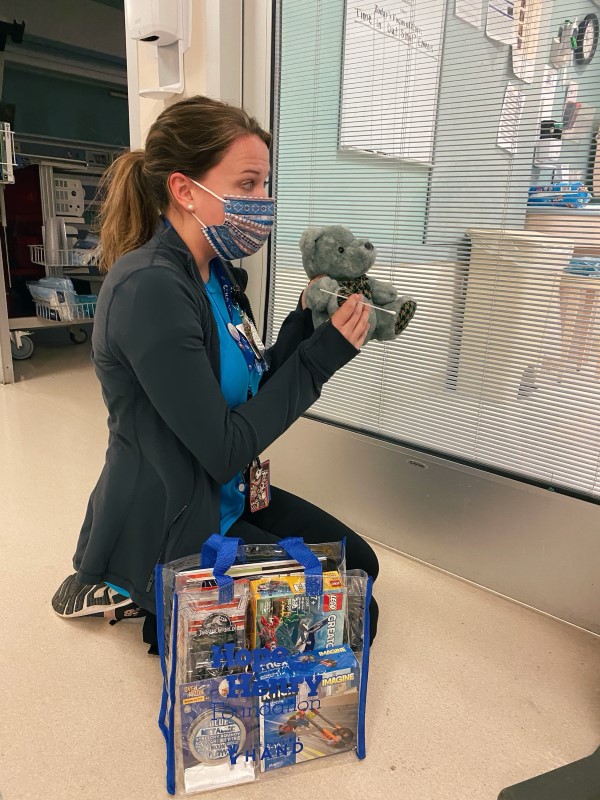Written by Laurie Strongin, CEO of Hope for Henry Foundation
Hope for Henry Child Life Specialist Liz crouched in the hallway outside the room of a six-year-old, unaccompanied boy who she has worked with many times in the past and explained over the hospital room intercom that the young boy would have a test to make sure doctors could take the best care of him. He was going to get a nasal swab to test for COVID-19.
No one will tell you that the long swab inserted into a patient’s nose all the way back into their throat, rotated to collect any viral specimens, and pulled out is remotely comfortable. One TikTok user described it as “like being stabbed in the brain.” But Liz explained to the child that she and her friends at the hospital were doing everything they could to keep him safe, that there is a virus traveling around the world, and that he needed a quick test to be sure he was healthy. If he could sit and talk to her while the nurse put something in his nose quickly, the test would be over faster. Then, on the other side of the glass wall of this little boy’s hospital room, he watched through the open blinds as Liz demonstrated the test on her own little patient, a stuffed bear.
The proliferation of COVID-19 has disrupted tens of millions of children’s lives. Instead of attending school, participating on sports teams, meeting friends for dinner, or playing in the park, kids across the country are housebound. Aside from the monotony of living in the same limited space for long periods of time, being quarantined can cause feelings of helplessness, anxiety, and fear in both kids and parents.
These feelings are not unfamiliar to chronically ill children whose treatment often necessitates years in and out of hospitals, but COVID-19 has made life far harsher for really sick kids. While otherwise healthy children tend to have milder symptoms than adults who contract COVID-19, the same isn’t true for a particularly high-risk group of pediatric patients — those with compromised immune systems who have had bone-marrow or solid-organ transplants or are being treated for cancer or a blood disorder.
Keeping these vulnerable children safe during this challenging time requires hospitals to make adjustments that exacerbate their isolation from everything they are fighting so hard for — normalcy and connection. To limit exposure, nearly every child is isolated in his or her hospital room. Playrooms and shared spaces are closed. Art and music therapists are no longer in hospitals working directly with kids. Volunteers who previously rocked sick babies or played games with hospitalized kids have been forced to cease their quality-of-life saving work. These kids are left with one caregiver, at best, or none if they have a single parent with other children at home who need supervision. And they are still enduring the difficult, painful medical treatment necessary to save their lives.
When a hospitalized child shows symptoms of COVID-19, frontline staff have to “rule out” the diagnosis. To protect the staff and other patients in their care, the caregivers have to assume that the child is positive for COVID-19 until proven otherwise. Therefore, all medical staff who enter the child’s room must wear PPEs, including a gown, gloves, mask, and face shield. These precautions can be intimidating and frightening — even, and perhaps especially, for kids who have spent months in the hospital for whom this new gear is unfamiliar and an obvious sign that something has changed, and not for the better.
Thankfully, Hope for Henry’s child life specialists like Liz are still in the hospital and have figured out how to support patients during COVID-19 testing while respecting hospital rules that prevent them from entering the patient rooms to limit exposure and use of scarce PPE. The preparation, coping strategies, distraction, and verbal support before, during, and after the test, along with a selection of toys and games that reward patients for coping so well and successfully completing the procedure, make something difficult a little bit easier. It helps build resilience and arms patients for their continued fight to recover. It enables medical staff to provide care faster so they can move on to the next patient. Because during times like these, there is always a next patient.

